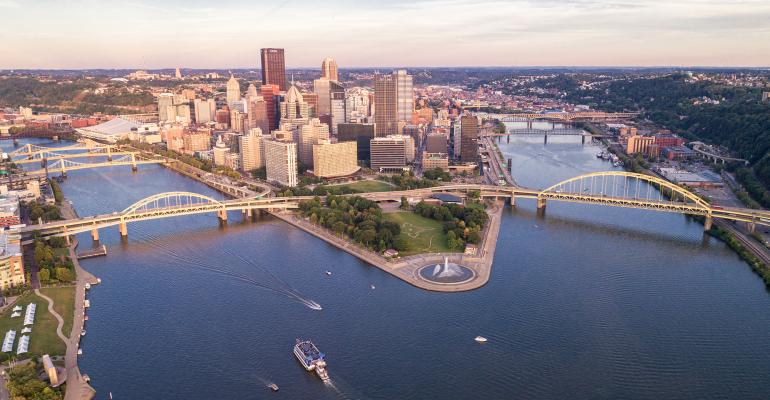(Bloomberg) -- Pittsburgh is more than 200 miles (320 kilometers) from the nearest coast, yet its office and retail buildings face $420 million in exposure to flood damage, or the third-greatest of any city in the U.S., according to a report published Monday. Commercial structures across the U.S could face up to $13.5 billion in damage in 2022, an amount that will rise at least 25% over the next 30 years as climate change exacerbates flooding from sea rise, storms and extreme rain events, according to First Street Foundation.
The report is the fourth on flooding from the Brooklyn-based technology startup whose goal is to publicize climate risks. The group collaborated with the commercial engineering firm Arup. The authors said that while residential flooding threats are well studied, the risks that climate change poses to commercial buildings are less familiar to the public. That’s problematic because commercial real estate is some of the nation’s most valuable, and provides essential tax revenue to municipalities.
“We are demonstrating that American businesses and local economies face much more uncertainty and unpredictability when it comes to the potential impact of flooding on their bottom line than they may realize,” said Matthew Eby, founder and executive director of First Street.
The report examined 3.6 million commercial properties and multi-storied residential buildings across the contiguous U.S. and found more than 700,000 with notable annualized flood risk.
To calculate the potential damage, the authors said they looked at characteristics such as whether the structure has a basement and whether it’s made of timber — both of which make buildings more susceptible to damage. They then calculated the likelihood of the building flooding now and into the next 30 years. From there, they then created a loss curve for 30 structure types, calculating losses by anticipated damage to things like elevators and electric outlets based on projected flood depths. The researchers then estimated losses to local economies from supply chain disruptions.
Many areas found to have the greatest vulnerability to flood damage were familiar: Florida, Louisiana and Texas. But there were surprises. Pittsburgh and Boston ranked third and fourth, respectively, out of metropolitan areas at risk. That’s because of the locations of their biggest buildings and shopping centers. Downtown Pittsburgh, for instance, sits at the confluence of three rivers.
The accuracy of First Street’s methods have drawn skepticism from other experts, who say that they are overstating how definitive their results are. They argue there isn’t enough information on all the variables for a completely accurate damage assessment. For example, digitized datasets of stormwater infrastructure, which could change flood risks block by block, aren’t available at scale.
Even if First Street’s report has flaws, Jesse M. Keenan, a professor of real estate at Tulane University in New Orleans said the commercial market does require more study. He hadn’t seen the First Street report and didn’t comment on it directly, but said dangers as the climate warms are likely consequential. “Capital market management of these risks is not well understood,” he said, “and neither is investor behavior.”
To contact the author of this story:
Leslie Kaufman in New York at [email protected]
© 2021 Bloomberg L.P.





